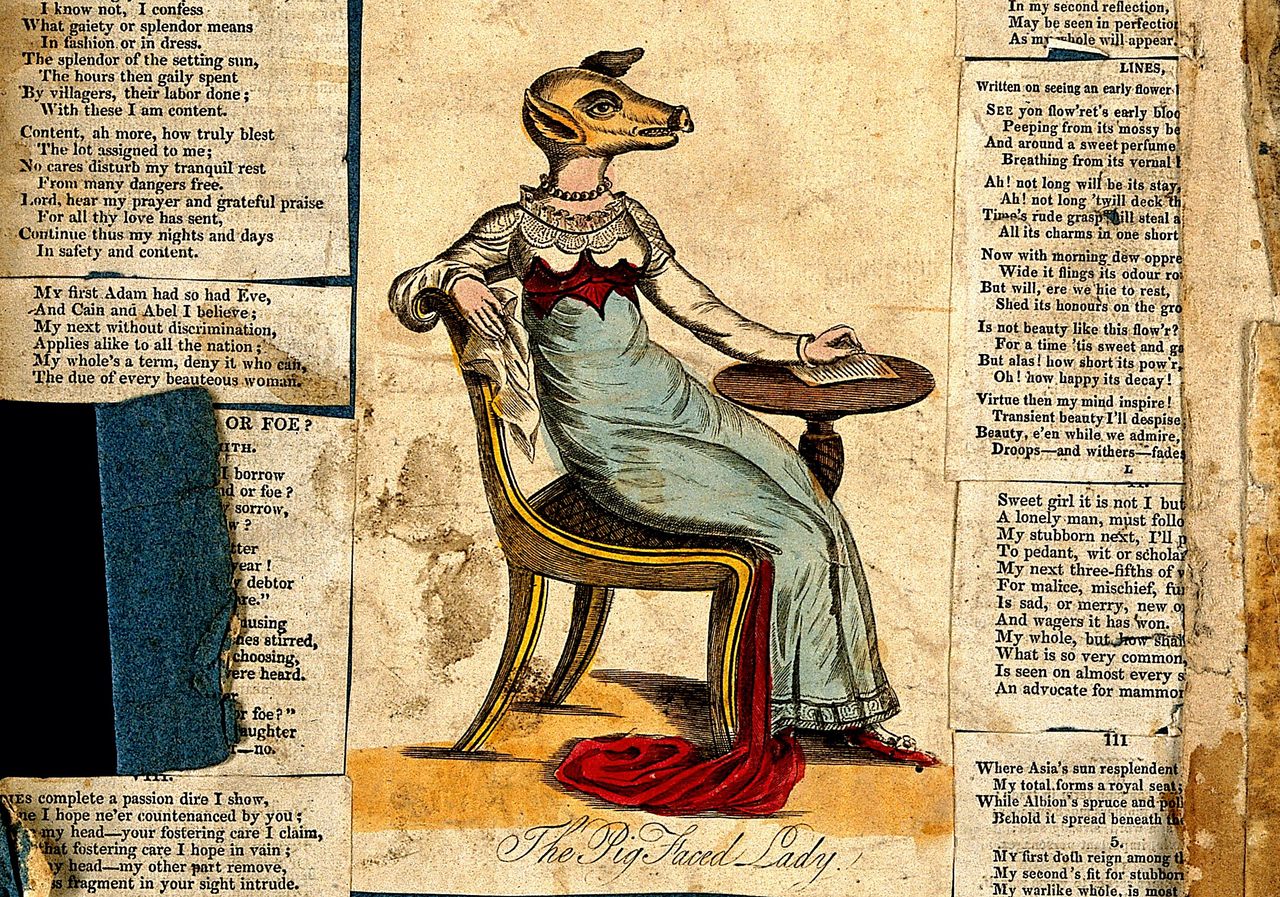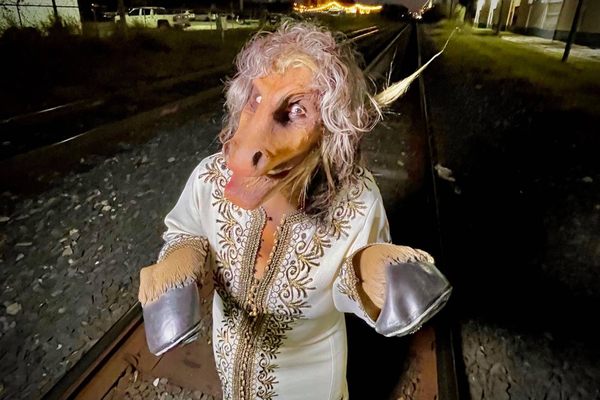Regency Londoners Were Obsessed With Pig-Faced Ladies
In 1815, the obsession with swine-ish, upper-class ladies reached a fever pitch.
Gathered around Piccadilly Street in the summer of 1815, Londoners were celebrating the recent British victory over Napoleon. The area was packed with people, forcing traffic to a crawl. As memoirist Rees Howell Gronow wrote in 1864, one carriage in particular drew the crowd’s attention. Some proclaimed that inside, they had seen an animal snout protruding from a trendy bonnet. It was none other than the infamous pig-faced lady, or so they claimed. Some shouted for the carriage to stop, crowding around the vehicle. Faced with the growing press of people, the driver hurried away.
As the person in that carriage surely learned, even the wildest rumors can bloom into a real-world frenzy. By the early 19th century, London’s growing news industry helped to transform the urban legend of a pig-faced lady into delirium.
Tales of a mysterious shut-in sporting a hog face appear as early as the 17th century. In one of the earliest stories, a pregnant Dutch housewife named Jacamijntjen Jacobs reportedly turned away a poor woman and her children who came begging at Jacobs’ door. According to Dutch doctor and writer Jan Bondeson’s The Two-Headed Boy, and Other Medical Marvels, the rebuffed beggar cursed Jacobs’ unborn child to turn out swine-ish and, as the legend goes, Jacobs’ daughter was subsequently born with a pig’s face.
That was much the same backstory for the supposedly pig-faced Tannakin Skinker, a wealthy Dutch woman whose mother rudely denied a beggar. In response, the beggar cursed Skinker causing her to develop a pigish appearance. Skinker was the subject of at least five different 17th-century ballads and a chapbook. Later, author Robert Chambers wrote in The Book of Days that some Dubliners believed that, despite her generosity, 18th-century philanthropist Griselda Steevens was also a pig-faced lady, though many dismissed it as a foolish rumor. Rather tellingly, these tales all concern women, perhaps because of a societal emphasis on physical beauty that rarely, if ever, produces similar stories of pig-faced men.

By the 19th century, the pig-faced lady had joined the ranks of other well-known monsters. People didn’t fear her the way they might’ve ghosts or werewolves. Nonetheless, she represented a queasy closeness with unclean barnyard hogs and the animalistic side of humanity. The contrast of this with her upper-class status made things all the more uncomfortable.
The legend also drew upon a long-standing fascination with monstrous births. Children born with bodily differences were understood to be signs of divine displeasure or, as time went on and scientific Enlightenment thought became more influential, results of a pregnant mother’s illness, emotional upset, or fundamental hereditary flaw. The tale draws on 18th-century, misogynistic, in which a woman’s value, morality, and social standing could be harshly judged based on her appearance.
“Monsters are one of the great universals in human history,” says McMaster University historian Michael Egan. “Every society has them. They create them.”
For Regency readers, the pig-faced lady of 1815 London may have remained an easily dismissed rumor if it weren’t for the newspapers. In the early months of that year, journalists and papers helped turn the pig-faced lady into something of a celebrity—despite skepticism of her existence.
In the February 9, 1815, issue of The Times, one woman said she wished to “undertake the care of a Lady who is heavily afflicted in the face,” using what was essentially a job wanted column to express her hope of a substantial salary for the position (though no known job listing for a pig-faced lady’s companion was posted before this). The Times quickly ridiculed believers, publishing a February 16 article to shame readers to reason: “Our rural friends hardly know what idiots London contains.” Still, The Times couldn’t help but describe the legend, which often placed the reclusive woman in an expensive neighborhood around Manchester or Grosvenor Square.
Shortly after the job wanted ad, matters escalated—this time with a marriage proposal posted only a week later. On February 17, 1815, The Times wrote that it had declined to print an anonymous man’s offer for the lady’s hand and claimed to have donated the listing fee, but the Morning Chronicle had no such qualms. In that publication, the man wrote that he was “desirous of explaining his Mind to the Friends of a Person who has a Misfortune in her Face.”

It’s possible a person with a physical disability may have inspired rumors of the pig-faced lady, potentially fueling a battle between believers and skeptics. In post-Enlightenment Europe, stories of “human monsters and birth anomalies are really starting. People are starting to think about monsters more scientifically than religiously,” says art historian Candace Livingston at Anderson University.
While this may have led some to believe the pig-faced woman was possible, there remained a sideshow-like fascination with her story, especially given the appearance of illustrated broadsides as part of the growing media interest. One printed by publisher John Fairburn included an account from the lady’s former maid who claimed that very good pay wasn’t enough to overcome squeamishness at seeing her mistress’ visage. Another broadside released by publisher George Smeeton alleged that the lady had ruled out the possibility of marriage and displayed an imagined portrait by caricaturist George Cruikshank, including a silver trough from which she dined. A particularly fantastical broadside shows her in full evening dress dancing with a figure representing the 8th Lord Kirkcudbright, already a caricature fixture.
Some stories turned the pig-faced lady into a more obvious monster. In his memoirs, Gronow recalled yet another tale in which the lady bit a rude gentleman visitor and chased him away with grunts, giving in to her animalistic side in a moment of indignation.
To many, it was all an obvious fabrication. Then why were even skeptical journalists so fascinated? Part of it centers on the tension between monstrosity and upper-class life, especially for women.
“If hypothetically there was a monstrous woman of a certain class, of polite society, well-educated, demure, but for her appearance, how do we respond?” says Egan. “Based on the letters and based on the reports, the answer’s probably not terribly well.”
A sense of morality and scientific curiosity swirled around the pig-faced lady. “Even in the 19th century,” says Livingston, “they would’ve assumed that there was a reason that this person was born that way, that it was sort of a cautionary tale.” A February 26, 1815, edition of The Examiner recounted a story in which a high-ranking lady was frightened by a dog while pregnant. She then reportedly gave birth to a daughter with a physical disability, with the writer hinting that the pig-faced lady’s mother may have suffered a similar incident.
Whether 1815’s pig-faced lady was an old-style folklore lesson like Tannakin Skinker or based on a real person with a physical disability, the pig-faced lady fascinated Londoners: The mere hint of her was enough for a crowd to rush someone’s carriage that day in Piccadilly. She represented many of London’s anxieties, from class tensions to women with disabilities to how upper-class polite society can be upended by someone who is visibly different.

No wonder that the mere hint of a pig-faced lady was enough for a crowd to rush someone’s carriage that day in Piccadilly. She represented many of London’s anxieties, from class tensions to women with disabilities to how upper-class polite society can be upended by someone who is visibly different.
By the summer of 1815, the story had begun to fade with only a smattering of additional news stories. In 1861, an anonymous man wrote to Notes and Queries magazine asking for more information regarding the lady and claiming to know reliable people who had seen her. One respondent claimed he had laid eyes on her in an exhibition around 1828. Later that year Charles Dickens wrote of the legend in All the Year Round: “In every age, I suppose, there has been a pig-faced lady,” referencing the tawdry sideshow association she had gained. At fairs and exhibitions, keen-eyed onlookers deduced that the pig-faced lady before them was really a drunken, shaved bear crammed into a dress and tied to a chair—a horrific display that would fall out of practice and effectively be outlawed in 1911 with the Protection of Animals Act.
Even though exploitative sideshows were largely gone by the end of the 20th century, and the downmarket spectacle of the pig-faced lady with them, the rumors of a pig-faced lady still fascinated people. Perhaps, in part, because the rumors illustrated the tensions between who we want to be—say, a refined, highly socialized upper-class person—and worries about our more animalistic nature. The pig-faced lady also speaks to how people treat differently-abled people and those with obvious bodily differences.
“We’re always going to be interested in people who have different bodies,” says Livingston. “Hopefully, as a society, we are handling [those bodily differences] better, more respectfully, and with a genuine desire to get to know people as humans, not just as some sideshow.”
After all, “monsters are a lot less interesting,” says Egan, than “the society imagining them.” Like any good monster story, the legend of the pig-faced lady may have more to say about us and our fascination with difference than the mysterious woman herself.





















Follow us on Twitter to get the latest on the world's hidden wonders.
Like us on Facebook to get the latest on the world's hidden wonders.
Follow us on Twitter Like us on Facebook